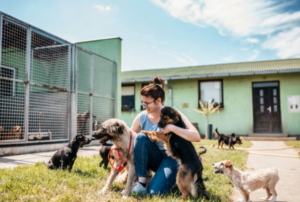Navigating the Ethical Maze

Within the vast world of animal shelters, an intricate and emotionally charged struggle unfolds—a battle not only against overpopulation but against the very fabric of ethical decision-making. At the heart of this multifaceted dilemma lies the controversial practice of euthanasia. This blog post endeavors to navigate the complexities surrounding euthanasia in animal shelters, a practice that walks the fine line between managing overpopulation and confronting the ethical dilemmas that tug at the conscience of shelter workers and animal advocates.
As we step into this realm, the backdrop reveals a stark reality: animal shelters are often inundated with a surplus of abandoned, stray, or surrendered animals. Causes ranging from irresponsible breeding to economic hardships that force owners to relinquish their pets contribute to the overwhelming challenge of accommodating these furry souls. In the face of this overpopulation crisis, shelters grapple with difficult decisions, and at times, the last resort emerges—euthanasia.
The Struggle of Overpopulation
The staggering influx of animals into shelters paints a poignant picture of a crisis rooted in multifaceted societal challenges. The contributing factors to this surge in shelter populations are as diverse as the animals themselves. Irresponsible breeding practices, compounded by a lack of widespread spaying and neutering initiatives, lead to an unchecked proliferation of litters. Economic hardships faced by pet owners, exacerbated by unforeseen circumstances or financial constraints, become insurmountable barriers, forcing them to part ways with their beloved companions.
In urban landscapes and rural enclaves alike, the consequences are palpable—shelters are inundated, stretching resources thin. Overcrowded kennels, strained budgets, and the Herculean task of providing adequate care to every resident creature become the daily struggles of shelter workers. The very essence of these shelters, designed to be places of refuge, morphs into a battlefield against a relentless tide.
While the spotlight often falls on the plight of dogs and cats, the overpopulation crisis extends to a myriad of species—rabbits, guinea pigs, exotic birds, and more—all seeking solace within the shelter walls. This overabundance not only tests the logistical capabilities of these organizations but also challenges the very principles they stand for: compassion, care, and the preservation of life.
The struggle of overpopulation in animal shelters is not merely a statistical phenomenon but a living, breathing testament to the interconnectedness of human actions and the lives of the voiceless beings caught in the crossfire. As we navigate this intricate web, it becomes increasingly apparent that addressing overpopulation requires a holistic approach—one that goes beyond the shelter walls and into the fabric of society itself.

Euthanasia as a Last Resort
As animal shelters confront the unrelenting wave of overpopulation, they find themselves standing at a crossroads where ethical considerations intersect with the pragmatic necessity of maintaining the welfare of their residents. Euthanasia, a term laden with emotional weight, emerges as the poignant punctuation at the end of a sentence fraught with difficult decisions.
The criteria for determining which animals become candidates for euthanasia are nuanced and heart-wrenching. Shelters often grapple with questions of age, health, temperament, and adoptability. The harsh reality is that resources—space, funding, and manpower—are finite, and shelters must make agonizing choices to prevent overcrowding that could compromise the well-being of every creature under their care.
Euthanasia, in this context, becomes a somber act of mercy, sparing animals from the potential suffering associated with overcrowded conditions or prolonged stays in shelters. However, it is a mercy met with internal conflict by shelter workers who, by the very nature of their roles, are staunch advocates for the well-being and preservation of animal life.
The decision-making process is guided by a delicate balance, teetering between the responsibility to safeguard the greater population within the shelter and the desire to afford every individual a chance at a better life. Shelter workers must navigate this moral tightrope daily, assessing each case on its merits and, in some instances, making decisions that challenge their own convictions.
As we peer into the world of euthanasia as a last resort, it’s crucial to recognize that this practice is not a reflection of callousness but a manifestation of the overwhelming challenges that shelters face. It is a coping mechanism, albeit a painful one, to prevent the deterioration of conditions within the shelter that could compromise the very ideals these organizations strive to uphold.
Beyond the logistical challenges and ethical dilemmas, the practice of euthanasia extracts a profound emotional toll on the compassionate individuals who dedicate their lives to the welfare of animals within shelters. Shelter workers, often fueled by an unbridled love for animals, find themselves caught in the crossfire between the imperative to make difficult decisions and the innate desire to protect and nurture every living being.
The act of euthanasia, regardless of its intent, leaves an indelible mark on the psyche of those who must carry it out. Shelter workers become silent witnesses to the fragility of life, tasked with shouldering the weight of choices that may be perceived as life-ending rather than life-preserving. The emotional toll manifests in various ways, from a pervasive sense of grief and loss to the insidious development of compassion fatigue.
Compassion fatigue, a phenomenon akin to burnout, emerges from the continuous exposure to traumatic situations and the chronic stress inherent in shelter work. The relentless cycle of welcoming new arrivals, forging fleeting bonds, and sometimes bidding farewell to those deemed unadoptable or beyond rehabilitation takes its toll. Shelter workers grapple not only with the sorrow of losing animals but also with the internal conflict arising from a system that necessitates such heart-wrenching decisions.
In an environment where resilience is tested daily, shelter workers develop coping mechanisms to navigate the emotional minefield. Peer support, counseling services, and initiatives promoting self-care become lifelines for those who shoulder the responsibility of euthanasia. The ability to compartmentalize, to forge a delicate balance between empathy and pragmatism, becomes an essential skill for individuals navigating the tumultuous waters of shelter work.
Acknowledging and addressing the emotional toll on shelter workers is pivotal in ensuring the sustainability of their commitment to animal welfare. This section underscores the importance of creating supportive environments within shelters, fostering a culture that recognizes the emotional labor involved and providing avenues for mental health support.

Alternatives to Euthanasia
Acknowledging the contentious nature of euthanasia within animal shelters, the quest for alternatives becomes a beacon of hope—offering the potential to simultaneously address overpopulation while upholding the values of compassion and preservation of life. This section explores a spectrum of alternatives that shelters can adopt in their mission to provide a lifeline for animals facing uncertain futures.
- Aggressive Spaying/Neutering Campaigns: One of the primary contributors to overpopulation lies in uncontrolled breeding. Aggressive spaying and neutering campaigns emerge as a proactive strategy to curb the influx of unwanted animals. By collaborating with veterinary clinics, community organizations, and governmental bodies, shelters can spearhead initiatives that make spaying and neutering more accessible and affordable. This preventative measure not only addresses the root cause of overpopulation but also aligns with a broader mission of responsible pet ownership.
- Education on Responsible Pet Ownership: The power of knowledge cannot be understated. Shelters can play a pivotal role in educating the community about responsible pet ownership. Outreach programs, workshops, and informational campaigns can enlighten pet owners about the importance of spaying/neutering, regular veterinary care, and the commitment required to provide a loving and lifelong home for their animal companions. Education becomes a cornerstone for creating a society that values and cares for its pets, reducing the frequency of surrenders and strays.
- Innovative Adoption Programs: Shelters can revolutionize their adoption strategies to increase the chances of animals finding forever homes. Implementing creative adoption programs, such as senior-to-senior matches, where older animals are paired with elderly adopters, or “foster-to-adopt” programs, can significantly enhance the success rate of adoptions. By tailoring programs to match the unique needs and circumstances of both animals and potential adopters, shelters create a more favorable environment for long-lasting connections.
- Collaboration with Rescue Organizations: Partnerships with rescue organizations can expand the network of support available to shelters. These collaborations can facilitate the transfer of animals to organizations specializing in particular breeds or species, increasing the likelihood of finding suitable homes. By leveraging the strengths of various groups within the animal welfare community, shelters can broaden their reach and provide more tailored solutions for each individual animal.
- Implementing Behavior Modification Programs: Behavior challenges often contribute to an animal’s likelihood of being deemed unadoptable. Shelters can develop and implement behavior modification programs that address common issues such as aggression or anxiety. Investing in the training and rehabilitation of animals not only improves their adoptability but also enhances the overall experience for adopters, ensuring a smoother transition into their new homes.

In the pursuit of alternatives to euthanasia, it becomes evident that a multifaceted approach is required—one that addresses the root causes of overpopulation while embracing the diversity of strategies available. This section underscores the significance of innovation and collaboration within the animal welfare community as we collectively strive to reshape the narrative surrounding the fate of shelter animals.
The Role of Advocacy and Legislation: This section will discuss the role of advocacy groups and legislative measures in influencing shelter policies and practices related to euthanasia. It will explore how public opinion and societal shifts can impact the decisions made by shelters and the potential for legal frameworks to mandate more humane practices.
Highlighting shelters that have successfully navigated the challenges of overpopulation without resorting to widespread euthanasia, this segment aims to inspire hope. By showcasing innovative approaches, community involvement, and the power of education, these success stories demonstrate that there are viable alternatives to address overpopulation while maintaining ethical standards.
The controversy surrounding euthanasia in animal shelters is undeniably complex, involving the delicate balance of compassion, ethics, and pragmatic decision-making. As we navigate this contentious terrain, it’s crucial to acknowledge the challenges faced by shelter workers, the emotional toll of euthanasia, and the importance of exploring alternative solutions. By shedding light on success stories and advocating for legislative changes, we can strive to create a future where the ethical dilemmas surrounding euthanasia are minimized, and the well-being of animals takes center stage. In doing so, we honor the commitment of those who work tirelessly to create a more compassionate world for our four-legged companions.

